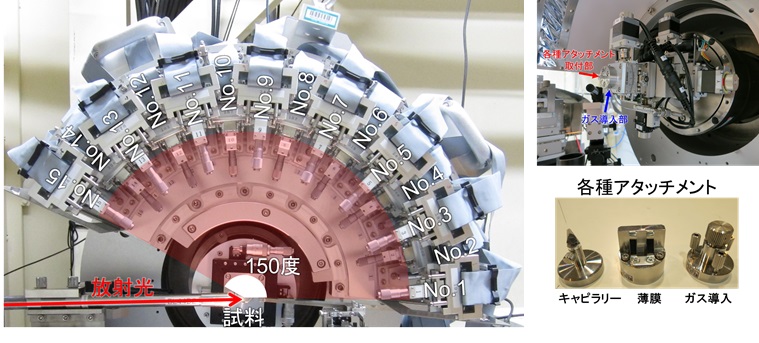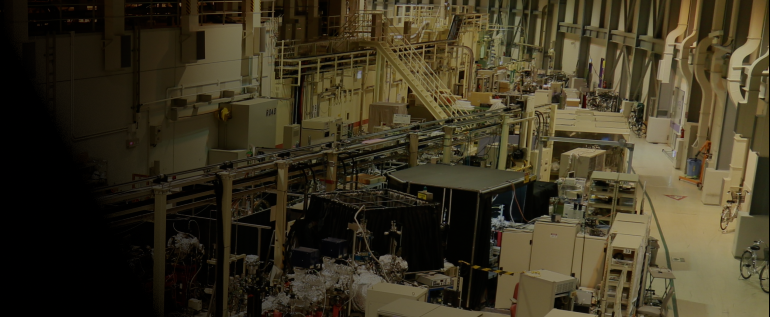全散乱計測装置
◆装置概要
この装置はブラッグ反射と散漫散乱の同時計測、つまり全散乱計測を前提に設計されています。一度の測定で、広い逆空間レンジ(散乱ベクトルの大きさQの最大値:30 Å-1)を高精細(Qのステップ:10-3 Å-1)かつ高S/N比(検出器のダイナミックレンジ:105~106)でカバーできるため、数Åの短距離秩序から数千Åの長距離秩序までの構造情報がシームレスに得られます。

◆装置の特徴
実験ハッチには、一次元光子計数型検出器システム“OHGI” (Overlapped High-Grade Intelligencer)1,2)を搭載した二軸粉末回折計が常設されています。このOHGIでは、2θ=0.5°から153°までを0.01°ステップで同時にデータを測定することができます。あらかじめ実験条件(X線エネルギーと検出器のエネルギー閾値)に合わせて検出器の感度ムラを補正することで、常時、光子計数型のダイナミックレンジを最大限活用した全散乱データを提供します3)。1) K. Kato et al., J. Synchrotron Rad. 26, 762-773 (2019).
https://doi.org/10.1107/S1600577519002145
2) 加藤 健一, 日本結晶学会誌 62, 26-34 (2020).
https://doi.org/10.5940/jcrsj.62.26
3) K. Kato et al., J. Synchrotron Rad. 27, 1172-1179 (2020).
https://doi.org/10.1107/S1600577520008929
◆装置アクセサリー
・窒素吹付低温装置(-180~200℃)
・窒素吹付高温装置(室温~800℃)
◆実験・試料準備
事前に試料をガラスキャピラリーに詰めて持参することを推奨します。キャピラリーのサイズは試料の組成や使用するX線エネルギーとも関係しますので、事前にご相談ください。
◆実験手順・注意事項
実験手順は一般的な粉末回折実験と同様です。ただ、どのような構造情報を得たいかによって測定時間が大きく異なりますので、事前にご相談ください。
◆問い合わせ先
加藤 健一 (このメールアドレスはスパムボットから保護されています。閲覧するにはJavaScriptを有効にする必要があります。)
◆代表的な論文リスト
“A statistical approach to correct X-ray response non-uniformity in microstrip detectors for high-accuracy and high-resolution total-scattering measurements”
K. Kato, Y. Tanaka, M. Yamauchi, K. Ohara, and T. Hatsui
J. Synchrotron Rad., 26, (2019) 762-773
https://doi.org/10.1107/S1600577519002145
“Nematic-to-columnar mesophase transition by in situ supramolecular polymerization”
K. Yano, Y. Itoh, F. Araoka, G. Watanabe, T. Hikima, and T. Aida
Science, 363, (2019) 161-165
https://doi.org/10.1126/science.aan1019
“Self-assembly of lattices with high structural complexity from a geometrically simple molecule”
H. Yamagishi, H. Sato, A. Hori, Y. Sato, R. Matsuda, K. Kato, and T. Aida
Science, 361, (2018) 1242-1246
https://doi.org/10.1126/science.aat6394
“Multielectron‐Transfer‐based Rechargeable Energy Storage of Two‐Dimensional Coordination Frameworks with Non‐Innocent Ligands”
K. Wada, K. Sakaushi, S. Sasaki, and H. Nishihara
Angew. Chem. Int. Ed., 57, (2018) 8886-8890
https://doi.org/10.1002/anie.201802521
“Rational synthesis of organic thin films with exceptional long-range structural integrity”
N. Seiki, Y. Shoji, T. Kajitani, F. Ishiwari, A. Kosaka, T. Hikima, M. Takata, T. Someya, and T. Fukushima
Science, 348, (2015) 1122-1126
https://doi.org/10.1126/science.aab1391
Total Scattering Measurement System
◆Equipment overview
The system is designed to take total scattering measurements through simultaneous measurements of Bragg and diffuse scattering.
In one measurement, a reciprocal space (Maximum magnitude of the scattering vector, Q: 30 Å-1), high definition (Q Step: 10-3 Å-1), and high S/N ratio (Dynamic range of the detector: 105~106) can be obtained. Therefore, structural information from short-range methods of several Å to long-ranged methods of several thousand Å can be obtained seamlessly.

◆Features of the Equipment
The experimental hatch has a biaxial powder diffractometer permanently installed, with a one-dimensional photon counting detector system “OHGI”(Overlapped High-Grade Intelligencer)1,2) equipped.OHGI has the ability to measure data from 2θ=0.5°to 153° in 0.01°simultaneous steps. By correcting the non-uniformity of the sensitivity of the detector according to the experimental conditions (X-ray energy and the energy threshold of the detector), full scattering data is provided that maximizes the dynamic range of the photon counting 3).
1) K. Kato et al., J. Synchrotron Rad. 26, 762-773 (2019).
https://doi.org/10.1107/S1600577519002145
2) K. Kato et al., Crystallographic Society of Japan 62, 26-34 (2020).
https://doi.org/10.5940/jcrsj.62.26
3) K. Kato et al., J. Synchrotron Rad. 27, 1172-1179 (2020).
https://doi.org/10.1107/S1600577520008929
◆Equipment accessories
・Low-temperature Nitrogen Spraying Device (-180~200℃)
・High-temperature Nitrogen Spraying Device (Room Temperature ~ 800℃)
◆Experiment / sample preparation
It is recommended that the sample be brought to the experiment inside a glass capillary. The size of the capillary depends on the composition of the sample as well as the energy of the X-rays used, so please contact us in advance for all of the necessary information.
◆Experimental procedure / precautions
The experimental procedure is similar to the procedure for a typical powder diffraction experiment. However, the measurement time varies depending on the structural information you wish to obtain, so please consult us in advance.
◆Contact
加藤 健一 (このメールアドレスはスパムボットから保護されています。閲覧するにはJavaScriptを有効にする必要があります。)
◆List of representative treatises
“A statistical approach to correct X-ray response non-uniformity in microstrip detectors for high-accuracy and high-resolution total-scattering measurements”
K. Kato, Y. Tanaka, M. Yamauchi, K. Ohara, and T. Hatsui
J. Synchrotron Rad., 26, (2019) 762-773
https://doi.org/10.1107/S1600577519002145
“Nematic-to-columnar mesophase transition by in situ supramolecular polymerization”
K. Yano, Y. Itoh, F. Araoka, G. Watanabe, T. Hikima, and T. Aida
Science, 363, (2019) 161-165
https://doi.org/10.1126/science.aan1019
“Self-assembly of lattices with high structural complexity from a geometrically simple molecule”
H. Yamagishi, H. Sato, A. Hori, Y. Sato, R. Matsuda, K. Kato, and T. Aida
Science, 361, (2018) 1242-1246
https://doi.org/10.1126/science.aat6394
“Multielectron‐Transfer‐based Rechargeable Energy Storage of Two‐Dimensional Coordination Frameworks with Non‐Innocent Ligands”
K. Wada, K. Sakaushi, S. Sasaki, and H. Nishihara
Angew. Chem. Int. Ed., 57, (2018) 8886-8890
https://doi.org/10.1002/anie.201802521
“Rational synthesis of organic thin films with exceptional long-range structural integrity”
N. Seiki, Y. Shoji, T. Kajitani, F. Ishiwari, A. Kosaka, T. Hikima, M. Takata, T. Someya, and T. Fukushima
Science, 348, (2015) 1122-1126
https://doi.org/10.1126/science.aab1391
